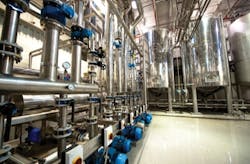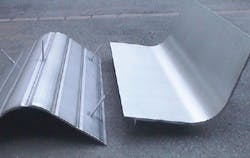Lead levels in drinking water linked to galvanic corrosion, disinfectants, pH
New research from Washington University in St. Louis shows that lead levels in drinking water spike when copper and lead pipes are joined.
By Diana Lutz
Lead pipes once used routinely in municipal water distribution systems are a well-recognized source of dangerous lead contamination, but new research from Washington University in St. Louis suggests that the partial replacement of these pipes can make the problem worse.
Galvanic Corrosion Causes New Lead Releases in Water Systems: Old lead water pipes are spliced to brand new copper pipes in Dan Giammar's lab at Washington University in St. Louis using either a plastic or a brass fitting. Homeowners end up with a similar setup if they decline to have their portion of a service line replaced. Giammar (above in red) has found that the juxtaposition of two dissimilar metals leads to galvanic corrosion that releases lead into the water. Credit: Joe Angeles/WUSTLThe research shows that joining old lead pipes with new copper lines using brass fittings spurs galvanic corrosion that can dramatically increase the amount of lead released into drinking water supplies.
"Work done in our laboratory shows galvanic corrosion in joined service lines is significant and lasts for a long time," says Dan Giammar, PhD, the Harold D. Jolley Career Development Associate Professor in the Department of Energy, Environmental & Chemical Engineering at Washington University in St. Louis.
His study, published in the Proceedings of the 2011 Water Quality Technology Conference, suggests that safety-minded, lead-pipe-removal programs at water utilities across the country actually may be increasing the risk of lead exposure for water customers.
An experiment running in his aquatic chemistry lab shows why. It features 80- to 100-year-old lead water pipes that were dug out of the ground in Washington, D.C., and shipped to his St. Louis laboratory. Some of the lead pipes have been cut and then joined with brass couplings to brand new copper pipe.
This setup mimics what happens if a utility company is replacing lead service lines and homeowners decline to have their sections of the lines replaced.
A service line runs from the main to the home. The utility owns the part from the main to the homeowner's property line and the homeowner owns the part from the property line to the house. The utility cannot replace the homeowner's half of the line unless the homeowner gives permission and pays for replacement. In the U.S. only 10 percent of homeowners agree to the charge.
"Since you started with a whole lead pipe and you now have half a lead pipe, you might think your problem would be half of what it was or -- maybe -- completely unchanged," Giammar says.
His experiment reveals that instead, it could be far worse. The joined lead-copper pipe in his lab releases five times more lead than did the original lead pipe.
The lead is released by galvanic corrosion, a process set up whenever two dissimilar metals are immersed in a conducting liquid.
The same thing happens if lasagna or another acidic dish is made in a stainless steel pan, covered with aluminum foil, and placed in a refrigerator. The two metals and the lasagna act as a galvanic cell, and some of the aluminum may migrate out of the foil and plate out on the surface of the lasagna.
The Lead and Copper Rule
The project to measure galvanic corrosion of lead pipes was the third Giammar has done for the Water Research Foundation, an organization of water utilities that allows them to pool their money to support research on problems of common interest.
Giammar, who calls himself a heavy metals guy, did his doctoral work on uranium contamination of soil and groundwater, work relevant to the far-flung branches of the Manhattan Project that purified uranium for the atomic bomb during World War II.
He still works on uranium remediation, but when he moved to St. Louis in 2002, he thought that he really ought to work on lead as well, because Missouri has historically been one of the two largest lead-producing states in the country. The other is Alaska.
Giammar began with experiments directed at understanding exactly what happens when phosphates are worked into lead contaminated soil. Under the right conditions, the phosphate will bind to the lead and immobilize it.
Phosphate remediation of lead contaminated soils had been successful in Joplin, Mo., a town located in the Tri-State district, an historic lead-zinc mining district that takes in parts of Missouri, Kansas and Oklahoma.
While Giammar was working with phosphates and soils, the media began reporting that lead levels in the tap water in Washington, D.C., were higher than before and indeed were higher than national drinking water standards allowed.
Lead, as Giammar says, is a "xenobiotic" element (literally foreign to living systems). Unlike some metals, it serves no biological purpose and only does harm. But lead pipes weren't outlawed in new construction until 1978.
That the district knew it had a problem was remarkable in itself. The levels of lead in drinking water weren't regulated until 1991, when the Lead and Copper Rule was passed.
The lead levels in Washington, D.C., drinking water began to rise in 2001.
The case of Washington, D.C., water
The lead levels rose for an interesting reason, says Giammar. The district water utility was trying to improve water quality.
In the U.S., he explains, water is delivered with a disinfectant still in it. There are two ways of chlorinating water to disinfect it. Utilities either use free chlorine, which is essentially bleach, or they use chloramines, which are essentially bleach combined with ammonia.
Free chlorine is a better disinfectant but it also forms higher concentrations of chlorinated disinfection byproducts -- things like chloroform -- that we don't want in our drinking water, Giammar says.
In an effort to decrease the concentrations of disinfection byproducts, the district switched from chlorine to chloramine.
This is where the water chemistry comes in. "The lead pipe, in itself, is not much of a concern," Giammar says. Pure lead, lead 0 as it's called, is not particularly reactive or soluble, which is one of the reasons people made plumbing out of it. Lead pipes last much longer than iron pipes.
But lead can oxidize -- essentially corrode. The lead species that then form determine how much lead ends up in the water. The various forms of lead in the +2 oxidation state are all more soluble than lead 0, but lead sulfate is more soluble than lead carbonate, which is in turn more soluble than lead phosphate. (The oxidation state of an element is a rough measure of how many electrons it has "lost" to other, nearby elements that are attracting the electrons more strongly.)
When it comes to lead in the +4 oxidation state there's a twist.
"If you have a strong oxidant, you can form species with lead in the +4 oxidation state," Giammar says. "These have very low solubility but they're only stable in the presence of a strong oxidant. As soon as the strong oxidant goes away, the lead +4 is no longer stable. It starts to come back to lead +2, and it can release the lead quite quickly."
The free chlorine the district had been using is a very strong oxidant. The chloramines they switched to are less strong.
"So when they switched to chloramines, the pipe scale that had formed over years of chlorine treatment began to release lead into the water," Giammar says. It was a classic example of an unintended consequence.
This is St. Louis water. "You might be surprised to know that the pH of St. Louis drinking water is 9 to 9.5," Giammar says, "much higher than the pH of distilled water, which is 7." In fact, it is heading toward milk-of-magnesia territory. He explains that the pH of the Missouri River is about 8, because the river flows through limestone, which makes the water somewhat alkaline. The limestone also makes the water hard, meaning it contains high levels of calcium and magnesium. So when it reaches the St. Louis water treatment plants, the pH is raised to between 10 and 11 to precipitate out some of the calcium carbonate and soften the water. The water utility then lets the pH drift back down to somewhere between 9 and 9.5 before the water is delivered. "It's a nice stable water with good water chemistry," Giammar says."Quite non-corrosive, has a good stable pH. They do all right with their distribution system," he says. By the way, St. Louis water is disinfected with chloramines rather than chlorine. Photo: USGSWhat the district case demonstrates, Giammar says, is that tap water is a manufactured product, not a natural resource. The water leaving the treatment plant can have essentially no lead in it, but by the time it reaches the faucet that could have changed.
The lead comes from the piping, but whether it is released depends on the chemistry of the water running through the distribution system.
Looking at water chemistry
When he read about the district problem, Giammar wrote a proposal to the Water Research Board offering to study the chemistry of the insides of pipes, particularly the dissolution rates of lead phosphates, lead carbonates and the lead +4 oxides, as a function of pH, added phosphate and disinfectants.
"That was our first entry into the field of lead and drinking water," he says.
"We knew pH would be an important variable," he says. "You don't want your pH to fall too low, especially for the lead carbonates, which dissolve at lower pH."
"But we didn't realize how important pH was. We studied water samples with a pH of 10, 8.5 and 7.5. You wouldn't think there would be a much of a difference between a pH of 8.5 and 7.5, but there was.
"In some cases, the pH made the difference between a lead concentration that met the drinking water standard and one that didn't."
Phosphate also turned out to be important. "It had a huge impact on the dissolution rates of all the lead corrosion products we studied," says Giammar.
So one way to bring down lead levels is to add phosphate. But phosphate costs money, so the utilities want to add as little of it as they can to produce a good-quality water.
"It's never going to be a one-size-fits all solution because the source-water compositions are different," says Giammar, "but we came up with some pretty strong recommendations."
The final report on the project, "Influence of Water Chemistry on the Dissolution and Transformation Rates of Lead Corrosion Products," was published last year.
Should you let the tap run?
"Another thing we studied in that first project," Giammar says, "was whether we should be more worried about reaction rates or about the equilibrium state of the reactions.
"To put it another way, if you let the water sit in the pipes for six hours, will it be different from water that sat in the pipes for only an hour?"
It turned out that most lead species dissolve relatively quickly, so reaction rates are not particularly important. The water is the same no matter how long the water has been sitting in the pipes.
But this isn't true of the lead +4 oxides, the material that formed the scale inside the Washington, D.C., pipes. "They are never at equilibrium with the water flowing over them," Giammar says. "Instead everything depends on the rate at which those oxides form or the rate at which they dissolve."
So Giammar proposed a second project for the Water Research Foundation just to study the lead +4 oxides. "They're fascinating solids," he says.
Then Giammar's lab picked up a third project. "A little over a year ago, I got a call from an environmental engineer in Washington, D.C., who was looking at something called galvanic corrosion and its potential to release lead into drinking water," he says.
This is the project that led to the centenarian lead pipe experiment now taking up much of the bench space in his lab.
Unlike some of the other water problems he has studied, galvanic corrosion is national in scope. The Environmental Protection Agency is concerned enough that it has appointed a science advisory board to make recommendations on how best to deal with it, Giammar says.
How low can we go?
It's difficult to talk about lead in a sensible way. The current threshold for drinking water is 15 micrograms per liter, Giammar says. And while there's talk in the community about lowering the allowable levels of some water contaminants, lead is not among them.
Environmental lead is ubiquitous and everyone has measurable levels of lead in their blood. We are exposed to it through dust and air as well as through water, thanks in part to the tetraethyl lead added to gasoline as an antiknock compound for 80 years.
"If your dominant exposure is through dust, there's little benefit to ratcheting down your exposure to water even further," Giammar says.
But, he says, because of the Lead and Copper Rule, water utilities now monitor lead levels. And he learned at a recent conference that during the most recent monitoring period, only 30 utilities had lead levels above the drinking water standard.
That may seem like a lot, he said, but there are roughly 54,000 water utilities in the U.S.
About the Author: Diana Lutz is a Senior Science Editor at Washington University in St. Louis. She can be reached at [email protected].
###




